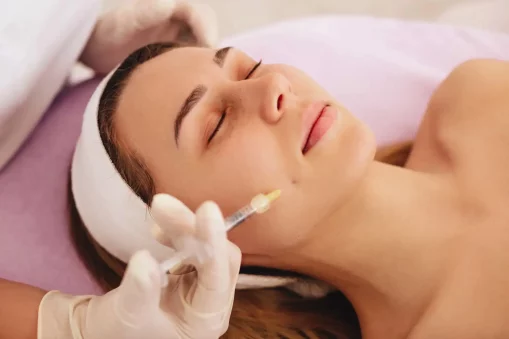Those who never had acne, think of scarring as just a purely cosmetic problem, but it often carries a lasting emotional impact for those affected. For many people who’ve dealt with moderate to severe acne, the scarring that follows can feel like a permanent reminder of a condition they’ve already fought hard to overcome.
Unlike temporary discoloration or textural roughness, atrophic acne scars involve deep dermal tissue loss, so treating them with surface-level therapies alone is practically impossible.
When you think of dermal fillers, acne scars probably aren’t the first thing that comes to mind. However, in recent years, dermal fillers have become very important for treating atrophic acne scars. Far beyond simply “filling in” depressions, the right filler triggers collagen production and boosts long-term skin remodeling.
We’ll examine which dermal fillers deliver the most effective results across various scar types.
Acne Scars 101
It is very important to understand the structural difference between acne scars. Patients will probably refer to acne scarring as a general condition, but you need to recognize that each scar type has its own morphology, depth, and response to intervention. Dermal fillers, in particular, must be chosen and applied taking these things into account.
Atrophic acne scars form when inflammation from acne disrupts normal dermal healing and leads to collagen degradation. Rather than regenerating a stable dermal matrix, the skin heals with a deficit of structural support, causing permanent depressions.
Acne scars are categorized into the following types, each with distinct characteristics:
- Ice pick scars: These are narrow (typically <2 mm), deep, and sharply defined. They often extend vertically into the dermis or even the subcutaneous layer, making them among the most challenging to treat.
- Boxcar scars: With well-demarcated edges and a broad, rectangular base (1.5–4 mm), these scars tend to respond well to volume restoration and subcision-assisted filler placement.
- Rolling scars: These are wider (>4–5 mm) with gentle, sloping edges. They’re usually the result of dermal tethering and subcutaneous fibrosis, which causes an undulating skin texture.
- Hypertrophic and keloid scars: Unlike the others, these are raised rather than depressed. They result from excessive collagen production during the healing process and typically require a different approach.
Comparison of Dermal Fillers for Acne Scarring
Each class of filler provides unique properties that can influence both immediate results and long-term tissue remodeling. Below, we explore the most widely used fillers for acne scar correction and assess how they perform.
Hyaluronic Acid (HA) Fillers
- Products: Juvederm®, Restylane®
- Best for: Superficial rolling scars, shallow boxcar scars
Hyaluronic acid (HA) fillers are often the first-line option for patients seeking minimally invasive improvement of atrophic acne scars. Their popularity stems from their versatility, safety, and reversibility. HA provides immediate volume restoration and dermal hydration, making it particularly useful for rolling or shallow boxcar scars where soft lift and smooth texture are the goals.
- HA fillers are fully reversible with hyaluronidase. This reversibility also makes HA an excellent starting point for patients new to injectable treatments.
- In a 2022 split-face study published in the Journal of Cosmetic Dermatology, a single session of HA filler improved scar depth by over 50%. However, clinical effects tended to diminish by the 9- to 12-month mark, emphasizing the need for maintenance.
While HA excels in precision and safety, it may fall short in treating tethered or deep scarring due to its softer consistency and relatively short duration.
Poly-L-lactic Acid (PLLA)
- Product: Sculptra®
- Best for: Diffuse rolling scars, volume loss in atrophic areas
Poly-L-lactic acid (PLLA) functions differently from HA. Rather than acting as a space-filling agent, it stimulates the body to produce its own collagen over time. This biostimulatory mechanism is good for broad, shallow rolling scars or areas where skin laxity exaggerates the appearance of scarring.
- PLLA typically requires a treatment series: usually three sessions spaced about six weeks apart.
- Gradual collagen production occurs over 3–6 months, creating smoother texture and subtle lifting.
- A double-blind study published in Dermatologic Surgery (2019) found that most patients treated with PLLA experienced improved skin quality.
However, PLLA’s diffuse nature makes it less suitable for sharply defined or ice pick scars. It requires proper dilution and injection technique to avoid nodularity, and results may take longer.
Calcium Hydroxylapatite (CaHA)
- Product: Radiesse®
- Best for: Deep rolling scars, medium boxcar scars
Calcium hydroxylapatite (CaHA) such as Radiesse (or even Ellansé polycaprolactone (PCL) is a hybrid approach: it delivers immediate volume through its dense microspheres plus also triggering neocollagenesis over time. Its firm consistency provides excellent support for deeper dermal planes.
CaHA is particularly effective when hyperdiluted (usually at a 1:1 or 1:2 ratio with saline and lidocaine) to reduce its viscosity and prevent rigidity.
Its lifting ability is superior to HA, yet it may not be appropriate for very superficial scars due to its high density and potential for palpability.
Polymethyl methacrylate (PMMA)
- Product: Bellafill®
- Best for: Moderate to severe rolling and boxcar scars
PMMA is the only filler with FDA approval specifically for the treatment of atrophic acne scars, which speaks to its efficacy in this indication. Bellafill® consists of non-absorbable PMMA microspheres suspended in a collagen gel carrier.
In a study published in the Journal of the American Academy of Dermatology (2014), 147 patients were treated with PMMA, showing sustained improvement in scar severity for up to 12 months, with a low rate of adverse events.
Because PMMA is permanent (not reversible), correct placement is critical. Overcorrection, superficial injection, and poor technique can result in visible nodules or granulomas.
Treatment Protocols
Suitable knowledge about products is certainly extremely important, but there are many other factors that must be assessed.
The technique used to deliver the filler is just as important as the filler itself. No single method suits all scar types:
- Linear threading and fanning are commonly used for rolling scars.
- The microdroplet technique is preferred in shallow or sharply demarcated boxcar scars.
Proper aftercare is also essential for both recovery and treatment longevity. Patients are advised to avoid strenuous activity, heat exposure, and facial massage for the first 24–48 hours. Mild swelling, redness, or bruising is common but usually resolves within 3 to 5 days.
Follow-up visits are scheduled at 4 to 6 weeks post-procedure.
Future in Acne Scar Management
Future protocols are likely to combine advanced biomaterials with precision diagnostics.
Hybrid Fillers
Emerging filler technologies are being designed with tunable rheology, meaning their viscosity, elasticity, and lift capacity can be adjusted according to scar type and other characteristics. These “hybrid fillers” may incorporate dual-phase compounds, controlled-release microspheres, or carrier molecules that modulate how the filler behaves once injected.
Some of these formulations are being engineered to release bioactive peptides, growth factors, or even anti-inflammatory agents in a delayed or sustained manner, potentially enhancing collagen production while minimizing immune response.
Imaging-Guided Treatments
Another exciting thing is the use of imaging-guided protocols for scar mapping and filler placement. High-frequency ultrasound and 3D skin imaging can help assess the depth, fibrosis, and orientation of scars with far greater accuracy than visual inspection alone.
Combining Fillers with Regenerative Therapies
The future is likely to favor combination therapies, where dermal fillers are used in synergy with regenerative modalities. Platelet-rich plasma (PRP), for instance, is already being combined with HA or CaHA fillers to amplify collagen synthesis and accelerate healing. Radiofrequency microneedling is another promising treatment that improves tissue texture and stimulates neocollagenesis.
Stem cell-derived treatments are under investigation as biological enhancers that could significantly improve dermal quality in scarred areas.
In Conclusion
Dermal fillers have truly changed what’s possible in the treatment of acne scarring. What was once considered a cosmetic intervention has now earned its place as an option for long-term scar revision. The appeal also lies in the flexibility these treatments offer. So, you, as a practitioner, can adjust each session based on the individual’s scar pattern, skin type, long-term goals, etc.
From hyaluronic acid-based fillers that offer immediate enhancement, to biostimulatory agents that upgrade collagen production over time, the spectrum of available products makes personalization very possible, and even often simple. Even permanent fillers, when used smartly and by skilled hands, have shown excellent results in the right patients.
Ultimately, it is impossible to say which product is the best because it depends on many factors, but Juvederm, Restylane, Sculptra, and Radiesse certainly stand out.
Frequently Asked Questions (FAQs)
How does ethnicity affect the choice of dermal fillers for acne scars?
Darker skin types are more prone to post-inflammatory hyperpigmentation and should be treated with caution. Softer, reversible fillers with lower inflammatory potential are typically preferred for these patients.
Can laser treatments and dermal fillers be combined for better acne scar results?
Yes, sequential or staged treatments combining lasers and fillers can produce synergistic improvements. Lasers resurface while fillers restore volume, but timing and modality selection must be carefully planned.
How do dermal fillers compare to fat grafting for atrophic acne scars?
Fillers are more affordable, predicatable, and cause less downtime, but fat grafting provides longer-lasting volume and regenerative potential. Choice depends on scar severity, patient preference, available resources, and other factors.
Is there a difference in filler efficacy for acne scars in older vs younger patients?
Yes, older patients often have thinner dermis and less collagen, which can affect filler performance. Biostimulatory fillers are more beneficial in mature skin.
What clinical signs suggest that a patient is a poor candidate for acne scar fillers?
Patients with unstable acne, keloid history, unrealistic expectations, or severely thinned skin may not respond well. A thorough assessment should always precede treatment planning.
References
Almukhadeb E, Binkhonain F, Alkahtani A, Alhunaif S, Altukhaim F, Alekrish K. Dermal Fillers in the Treatment of Acne Scars: A Review. Ann Dermatol. 2023 Dec;35(6):400-407. doi: 10.5021/ad.22.230. PMID: 38086353; PMCID: PMC10733075.
Abdel Hay R, Shalaby K, Zaher H, Hafez V, Chi CC, Dimitri S, Nabhan AF, Layton AM. Interventions for acne scars. Cochrane Database Syst Rev. 2016 Apr 3;4(4):CD011946. doi: 10.1002/14651858.CD011946.pub2. PMID: 27038134; PMCID: PMC7069546.
Basta-Juzbašić A. Current therapeutic approach to acne scars. Acta Dermatovenerol Croat. 2010;18(3):171-5. PMID: 20887698.
Joseph JH, Shamban A, Eaton L, Lehman A, Cohen S, Spencer J, Bruce S, Grimes P, Tedaldi R, Callender V, Werschler P. Polymethylmethacrylate Collagen Gel-Injectable Dermal Filler for Full Face Atrophic Acne Scar Correction. Dermatol Surg. 2019 Dec;45(12):1558-1566. doi: 10.1097/DSS.0000000000001863. PMID: 30829754.



0 Comments